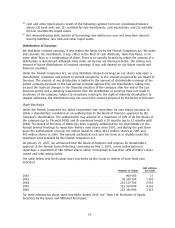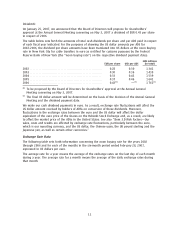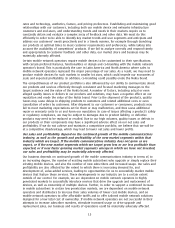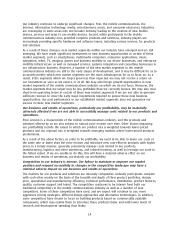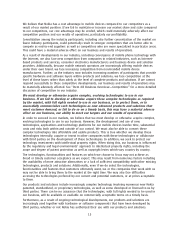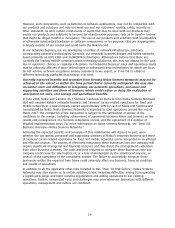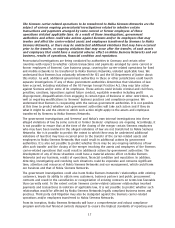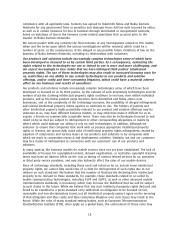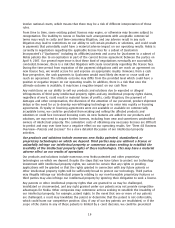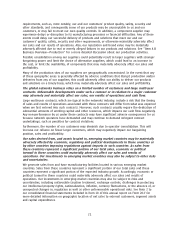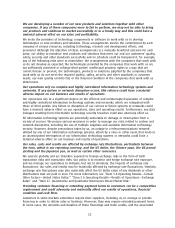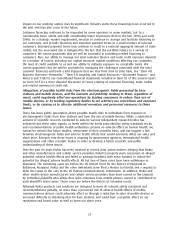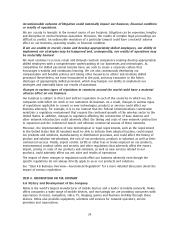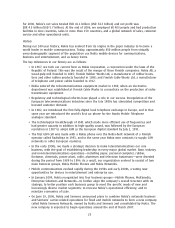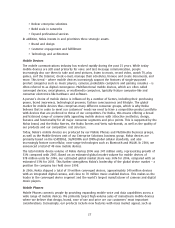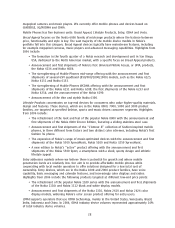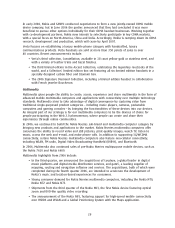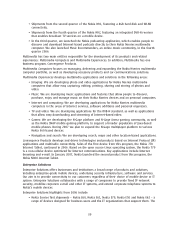Nokia 2006 Annual Report Download - page 21
Download and view the complete annual report
Please find page 21 of the 2006 Nokia annual report below. You can navigate through the pages in the report by either clicking on the pages listed below, or by using the keyword search tool below to find specific information within the annual report.from using such patent as a basis for product differentiation or from licensing the invalidated or
limited portion of our intellectual property rights, or we could lose part or all of the leverage we
have in terms of our own intellectual property rights portfolio. Even if such a patent challenge is not
successful, it could be expensive and timeconsuming, divert management attention from our
business and harm our reputation. Any diminution of the protection that our own intellectual
property rights enjoy could cause us to lose some of the benefits of our investments in R&D, which
may have a negative effect on our results of operations. See ‘‘Item 4.B Business Overview—Patents
and Licenses’’ for a more detailed discussion of our intellectual property activities.
Our sales and results of operations could be materially adversely affected if we fail to
efficiently manage our manufacturing and logistics without interruption, or fail to ensure
that our products and solutions meet our and our customers’ quality, safety, security and
other requirements and are delivered on time.
Our manufacturing and logistics are complex, require advanced and costly equipment and include
outsourcing to third parties. These operations are continuously modified in an effort to improve
manufacturing efficiency and flexibility. We may experience difficulties in adapting our supply to
meet the demand for our products, ramping up or down production at our facilities as needed,
maintaining an optimal inventory level, adopting new manufacturing processes, finding the most
timely way to develop the best technical solutions for new products, managing the increasingly
complex manufacturing process for our highend products, particularly the software for these high
end products, or achieving manufacturing efficiency and flexibility, whether we manufacture our
products and solutions ourselves or outsource to third parties. Such difficulties may have a material
adverse effect on our business and results of operations and may result from, among other things,
delays in adjusting or upgrading production at our facilities, delays in expanding production
capacity, failure in our manufacturing and logistics processes, failures in the activities we have
outsourced, and interruptions in the data communication systems that run our operations. Also, a
failure or an interruption could occur at any stage of our product creation, manufacturing and
delivery processes, resulting in our products and solutions not meeting our and our customers’
quality, safety, security and other requirements, or being delivered late compared to our own
estimates or customer requirements, which could have a material adverse effect on our business, our
results of operations and reputation, and the value of the Nokia brand.
We depend on a limited number of suppliers for the timely delivery of components and sub
assemblies and for their compliance with our supplier requirements, such as our and our
customers’ product quality, safety, security and other standards. Their failure to do so could
materially adversely affect our ability to deliver our products and solutions successfully and
on time.
Our manufacturing operations depend to a certain extent on obtaining adequate supplies of fully
functional components and subassemblies on a timely basis. In mobile devices, our principal supply
requirements are for electronic components, mechanical components and software, which all have a
wide range of applications in our products. Electronic components include integrated circuits,
microprocessors, standard components, memory devices, cameras, displays, batteries and chargers
while mechanical components include covers, connectors, key mats and antennas. Software includes
various thirdparty software that enables various new features and applications to be added, like
thirdparty email, into our products. In networks business, components and subassemblies sourced
and manufactured by thirdparty suppliers include Nokiaspecific integrated circuits and radio
frequency components; servers; subassemblies such as printed wire board assemblies, filters,
combiners and power units; and cabinets.
In addition, a particular component may be available only from a limited number of suppliers.
Suppliers may from time to time extend lead times, limit supplies or increase prices due to capacity
constraints or other factors, which could adversely affect our ability to deliver our products and
solutions on a timely basis. Moreover, a component supplier may fail to meet our supplier
20


